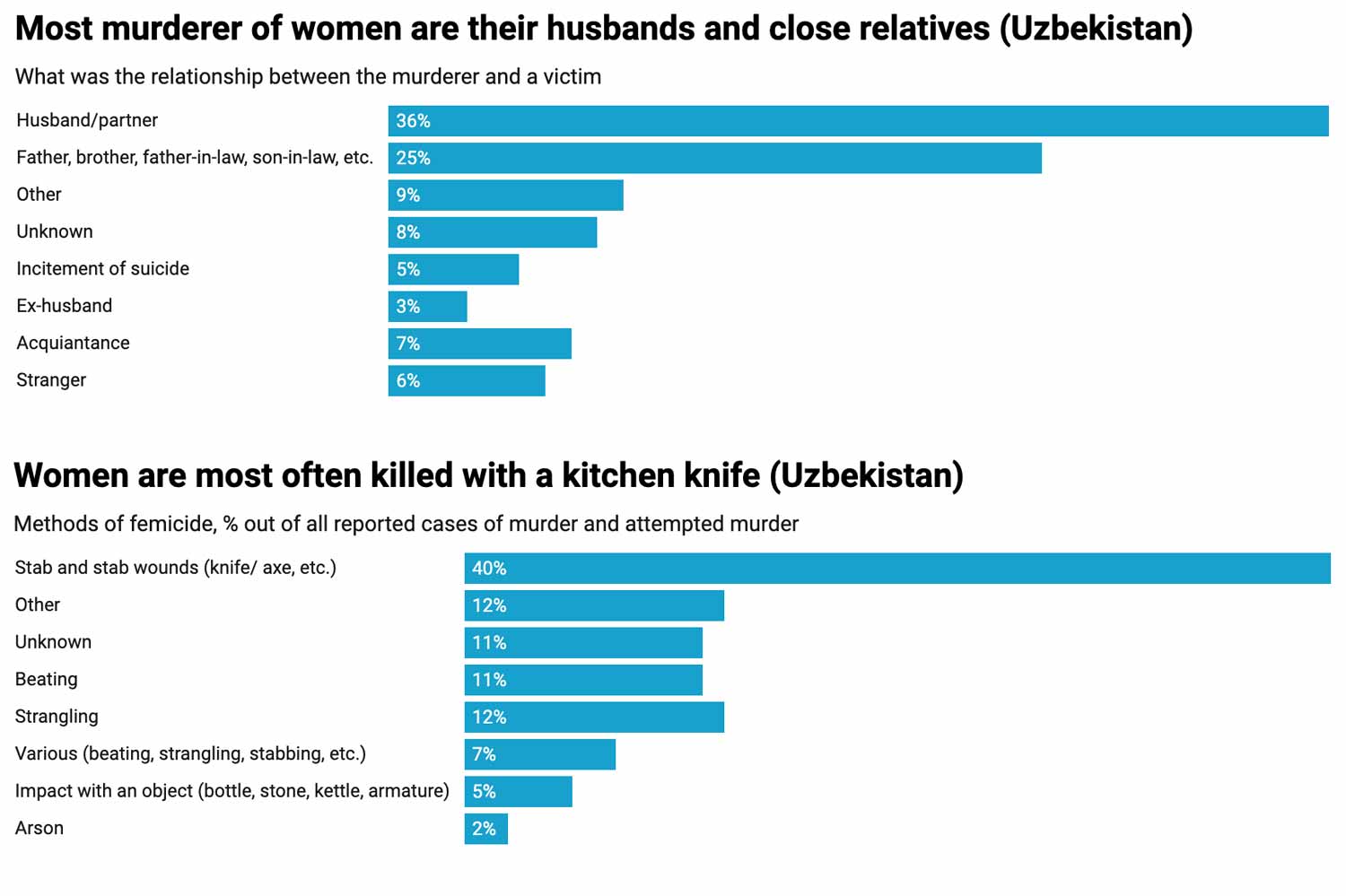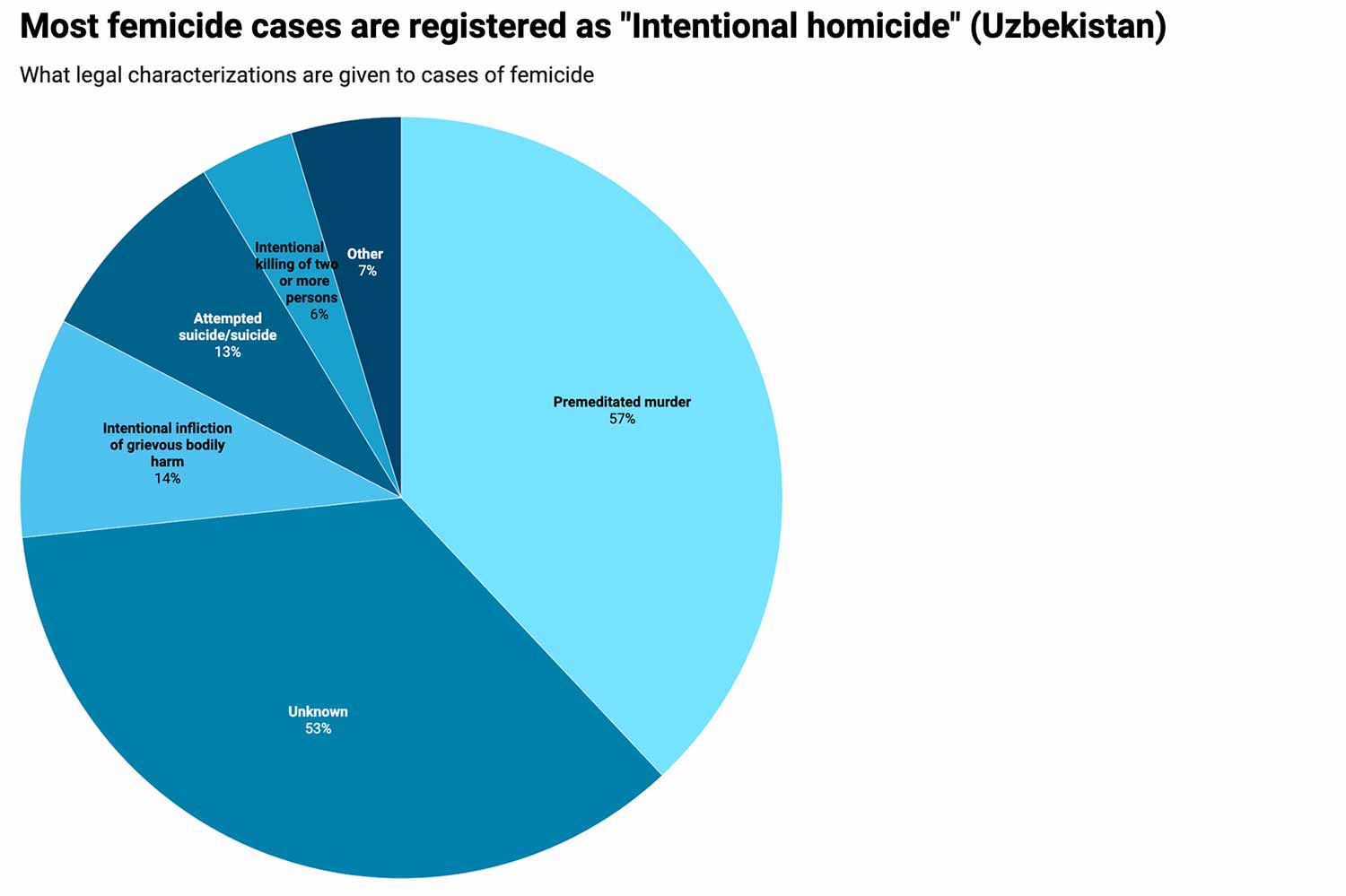Femicide in Uzbekistan
In the absence of official statistics, data analysis reveals shocking extent of gender-related murders.
On June 13, 2020, a resident of Namangan killed his wife with an axe during an argument. He then attacked his three young daughters, murdering the four-month-old baby, before killing himself. This is femicide.
On June 4 2022, in a village in Fergana province, a father found out that his 16-year-old daughter had gone on a date and repeatedly hit her on the head until she lost consciousness. The father ordered her not to speak to the boy again. The girl subsequently died of her injuries; her father was charged with grievous bodily harm resulting in death. This is femicide.
A 21-year-old woman came home late from work. Her husband, furious that she had not cleaned the house or made dinner, attacked and beat her to death. The man was jailed for nine years. This, too, is femicide.
There are no statistics on cases of femicide - the killing of women on the grounds of hatred of women, with the acquiescence of the state - in Uzbekistan. According to the UN and Global Centre of Excellence on Gender Statistics, counting gender-related killings requires a standardised methodology to distinguish those driven by gender-related motives from overall female homicides.
However, an analysis of murder cases of women published in the Uzbek media between 2015 and 2023 revealed that proves that most of them OUT OF HOW MANY can be qualified as femicide.
Official statistics in Uzbekistan reveal only the gender of criminal offenders, not victims. Instead, these cases are recorded under broader categories of homicide, murder or intentional infliction of grievous bodily harm. The gender-based nature of certain crimes can only be reflected in the official data on sexual assault cases.

To analyze the phenomenon, more than 6,000 news reports from 2015 to 2023 were logged. More than 150 cases of gender-motivated killings that match the 2022 UN and European Institute for Gender Equality criteria of femicide were identified.
The victims had previously been physically, sexually, or psychologically abused by the killer, been involved in sexualised exploitation, targeted because of a prejudice against women or had had their bodies mutilated. There were many more cases of women being murdered or driven to suicide, but which lacked enough context to categorise as femicide.
The Uzbek-language media often broadcast victim-blaming -shifting responsibility for what happened to the victim of violence - in news about femicide. In 2019, one murder was published under the supposedly humorous headline “Samarkand’s Othello Killed His Wife.”
Nonetheless, news reports can often be used to fill gaps in statistics, as there are no official figures on murders of women by partners or relatives. The prosecutor general’s office did not respond to inquiries.
An April 2022 law enforcement report on the previous year indicated that of 39,343 reports of pressure and violence against women and girls, 34,330, or 87 per cent, were committed in the home.
“There is ample evidence that gender-motivated murders of women and girls are committed by current or former intimate partners or other family members,” the 2022 UN report explained. “Female homicides are often linked to men’s need to control or punish women for behaviour deemed unacceptable, and the evidence suggests that women are particularly frequent victims of this type of intentional homicide.”
The database corroborated these findings. In most cases, the woman knew her killer – her husband, boyfriend, roommate, ex-husband or male relative.
The main motive for the killings arose against the background of male aggression: because a woman did not give birth to boys, did not perform household chores, wanted a divorce, was bullied by y her mother-in-law or subjected to systematic violence by her husband.
An Amnesty International 2022 report noted that "the situation is further exacerbated by a sharp increase in traditionalist, patriarchal and overtly misogynistic political rhetoric,” adding, "The pervasive, deeply traditionalist approach to resolving intrafamily conflicts remains one of the main obstacles to greater protection for victims.”
Domestic violence is often spurred by jealousy on the part of a spouse who sees his wife as his property. This is the second most common motive cited in female homicide cases.
Cases of women being murdered by another woman can also be considered acts of femicide if the crime is committed for male gain or if the victim does not conform to patriarchal attitudes and cultural norms.
"In the context of such harmful customs, not only male but also female relatives may intentionally attack the victim," the UN report said.
The analysis showed that in 60 percent of the cases the women were killed with a kitchen knife or bladed weapons such an axe, hoe, scissors or a chainsaw. Most of the victims suffered multiple stab wounds.
The second most common cause of death were beatings and strangulation.
According to the database, 57 per cent of crimes where the victim was a woman are registered as premeditated murder. Some intentional homicides have the aggravating factor of the murdered woman being pregnant or children being killed.
Almost a quarter of the cases were recorded under "intentional infliction of grievous bodily harm" and liable for a punishment of up to ten years in prison. These are usually cases in which the husband beat his wife to death with his bare hands.
Almost a quarter of cases involved suicide, which activists have described as indirect femicide.
There are several cases of young girls who committed suicide following domestic violence or abuse. However, in all of these cases, the prosecutor's office refused to initiate criminal proceedings.

"It is very difficult to prove suicide because there is no direct evidence in most cases and everything depends on the quality of forensic and forensic psychological examination and investigation bodies," said lawyer Dilfuza Kurolova.
The government is taking some steps to reduce violence against women. Most recently, in April 2023, a law on amendments to protect women and children from violence came into force.
This established separate liability for domestic violence and harassment, and deemed not violation of rights - to property, education, health and labour - insults, threats and forced separation to be domestic violence.
The length of a protection order was extended from 30 days to up to one year. Penalties for sexual violence were also been tightened.
However, experts and human rights activists hold out little hope for this law because of Uzbekistan's patriarchal traditions, not to mention corruption and the apathy of law enforcement agencies.
And although Kurolova was one of the experts involved in drawing up the bill, she warned that the criminalisation of domestic violence would not have much effect on rates of femicide. The working groups recommendations of criminalising both economic and psychological violence were opposed by parliamentary researchers.
"Unfortunately, [this law] will not be able to prevent [femicide] because there is still psychological and financial violence,” she said. “The victim has the right to take back the complaint and stop any investigation, and that's a big problem. To do that, we need to revise or remove Article 66-1 of the Penal Code, under which a suspect can be absolved of criminal responsibility due to reconciliation.”
Another expert working in the field of women's rights, who asked to remain anonymous, said that while criminalising domestic violence was a positive step, increasing punishment alone will not solve the problem.
"We see that the role of women in Uzbekistan, despite the efforts of the government and a more active civil society, has been declining in recent years,” she said. “This is also because there is zero tolerance for violence in society as a whole. We also see that a patriarchal attitude towards girls and women is being imposed in our society, using, it seems to me, not quite correct, but rather a completely wrong interpretation of the rules in Islam on the upbringing and role of women in society, which only speak of the responsibilities of women, and forget to mention the responsibilities of men in relation to women.”
The data was extracted using a Javascript automation library called Puppeteer. The source news sites were hand-picked, and the parser code customised for each individually. The search used phrases common in texts about femicide crimes, such as "killed his wife", "chopped up his wife", "stabbed his wife", "murdered", "body found", etc. The word "wife" was also changed to "woman" and "girl.” The data was extracted and imported into an Excel spreadsheet. The material was prepared on the basis of the GIJN guidelines, the UN report and the femicide research methodology of Kloop.kg.
Data analysis code by Armin Sarajlic.
This article was first published by CABAR.

